This page was generated from
docs/Examples/Error_propagation/Cpx_Liq_Thermobarometry_Error_prop.ipynb.
Interactive online version:
.
Error propagation - Cpx-Liquid.
This notebook demonstrates how to propagate errors in Cpx-Liquid thermobarometry
This builds on from the notebook showing how to consider error in a single phase (Liquid_Thermometry_error_prop.ipynb). We suggest you look at that first, as its simpler when you don’t have to worry about two separate phases
We use the experimental data of Feig et al. (2010) - DOI 10.1007/s00410-010-0493-3, and the author-stated 1 sigma errors
You can download the excel file here https://github.com/PennyWieser/Thermobar/blob/main/docs/Examples/Error_propagation/Cpx_Liq_Error_prop_Feig2010_example.xlsx
You need to install Thermobar once on your machine, if you haven’t done this yet, uncomment the line below (remove the #)
[1]:
#!pip install Thermobar
[2]:
# Import other python stuff
import numpy as np
import pandas as pd
import matplotlib.pyplot as plt
import Thermobar as pt
pd.options.display.max_columns = None
pt.__version__
[2]:
'1.0.36'
Importing data
[3]:
out=pt.import_excel('Cpx_Liq_Error_prop_Feig2010_example.xlsx', sheet_name="Sheet1")
my_input=out['my_input']
myCpxs1=out['Cpxs']
myLiquids1=out['Liqs']
[4]:
## Check input looks reasonable
display(myCpxs1.head())
display(myLiquids1.head())
| SiO2_Cpx | TiO2_Cpx | Al2O3_Cpx | FeOt_Cpx | MnO_Cpx | MgO_Cpx | CaO_Cpx | Na2O_Cpx | K2O_Cpx | Cr2O3_Cpx | Sample_ID_Cpx | |
|---|---|---|---|---|---|---|---|---|---|---|---|
| 0 | 51.075956 | 0.325086 | 4.892502 | 5.714957 | 0.165700 | 16.897042 | 20.466034 | 0.319704 | 0 | 0.252186 | Feig2010_1 |
| 1 | 51.578350 | 0.356860 | 3.600200 | 6.390180 | 0.171190 | 16.402000 | 20.388060 | 0.332720 | 0 | 0.186270 | Feig2010_2 |
| 2 | 51.567875 | 0.256271 | 4.763807 | 4.229021 | 0.000000 | 16.969344 | 21.061352 | 0.316506 | 0 | 0.528929 | Feig2010_3 |
| 3 | 52.083950 | 0.325983 | 3.919567 | 5.285317 | 0.168583 | 16.604683 | 20.364050 | 0.318067 | 0 | 0.377937 | Feig2010_4 |
| 4 | 52.331846 | 0.406175 | 3.974610 | 6.039907 | 0.173175 | 16.297102 | 19.784783 | 0.388863 | 0 | 0.285975 | Feig2010_5 |
| SiO2_Liq | TiO2_Liq | Al2O3_Liq | FeOt_Liq | MnO_Liq | MgO_Liq | CaO_Liq | Na2O_Liq | K2O_Liq | Cr2O3_Liq | P2O5_Liq | H2O_Liq | Fe3Fet_Liq | NiO_Liq | CoO_Liq | CO2_Liq | Sample_ID_Liq | |
|---|---|---|---|---|---|---|---|---|---|---|---|---|---|---|---|---|---|
| 0 | 50.973845 | 0.489282 | 19.349173 | 5.327336 | 0 | 4.511373 | 9.161873 | 4.205536 | 0 | 0 | 0 | 5.12 | 0 | 0 | 0 | 0 | Feig2010_1 |
| 1 | 53.642629 | 0.617371 | 19.320971 | 4.884986 | 0 | 3.257343 | 6.824314 | 5.057043 | 0 | 0 | 0 | 5.18 | 0 | 0 | 0 | 0 | Feig2010_2 |
| 2 | 49.629083 | 0.365787 | 19.103075 | 5.302860 | 0 | 6.403377 | 11.615943 | 3.275783 | 0 | 0 | 0 | 5.05 | 0 | 0 | 0 | 0 | Feig2010_3 |
| 3 | 51.624314 | 0.443871 | 18.451100 | 6.303071 | 0 | 6.132229 | 10.365057 | 3.685714 | 0 | 0 | 0 | 2.67 | 0 | 0 | 0 | 0 | Feig2010_4 |
| 4 | 53.980586 | 0.817471 | 17.454986 | 6.744429 | 0 | 5.149100 | 9.030871 | 4.179543 | 0 | 0 | 0 | 2.25 | 0 | 0 | 0 | 0 | Feig2010_5 |
Example 1: Uncertainty in a single input parameter for Cpx-only and Cpx-Liq barometry
Here, we consider the effect of adding just 5% noise to measured Na2O contents of Cpx (a fairly typical uncertainty resulting from EPMA analyses)
Because our liquids and cpx dataframes need to be the same size to feed into the calculate_Cpx_Liq functions, we also use the add_noise_sample_1phase to generate a dataframe of Liq compositions, however, we simply state noise_percent=0 so all the rows for each liquid are identical
[5]:
# Make liquid dataframe of the right size, no noise added
Liquids_only_noNoise=pt.add_noise_sample_1phase(phase_comp=myLiquids1,
noise_percent=0, duplicates=1000, err_dist="normal")
All negative numbers replaced with zeros. If you wish to keep these, set positive=False
[6]:
# Make Cpx dataframe, with 5% random noise added to Na2O
Cpx_5Na2O=pt.add_noise_sample_1phase(phase_comp=myCpxs1, variable="Na2O",
variable_err=5, variable_err_type="Perc", duplicates=1000, err_dist="normal")
Cpx_5Na2O.head()
All negative numbers replaced with zeros. If you wish to keep these, set positive=False
[6]:
| SiO2_Cpx | TiO2_Cpx | Al2O3_Cpx | FeOt_Cpx | MnO_Cpx | MgO_Cpx | CaO_Cpx | Na2O_Cpx | K2O_Cpx | Cr2O3_Cpx | Sample_ID_Cpx_Num | Sample_ID_Cpx | |
|---|---|---|---|---|---|---|---|---|---|---|---|---|
| 0 | 51.075956 | 0.325086 | 4.892502 | 5.714957 | 0.1657 | 16.897042 | 20.466034 | 0.303531 | 0 | 0.252186 | 0 | Feig2010_1 |
| 1 | 51.075956 | 0.325086 | 4.892502 | 5.714957 | 0.1657 | 16.897042 | 20.466034 | 0.325616 | 0 | 0.252186 | 0 | Feig2010_1 |
| 2 | 51.075956 | 0.325086 | 4.892502 | 5.714957 | 0.1657 | 16.897042 | 20.466034 | 0.307201 | 0 | 0.252186 | 0 | Feig2010_1 |
| 3 | 51.075956 | 0.325086 | 4.892502 | 5.714957 | 0.1657 | 16.897042 | 20.466034 | 0.303318 | 0 | 0.252186 | 0 | Feig2010_1 |
| 4 | 51.075956 | 0.325086 | 4.892502 | 5.714957 | 0.1657 | 16.897042 | 20.466034 | 0.347571 | 0 | 0.252186 | 0 | Feig2010_1 |
[7]:
# Plot what the Na content looks like
plt.hist(Cpx_5Na2O['Na2O_Cpx'].loc[Cpx_5Na2O['Sample_ID_Cpx_Num']==0], ec='k')
plt.xlabel('Na2O Cpx #0')
[7]:
Text(0.5, 0, 'Na2O Cpx #0')
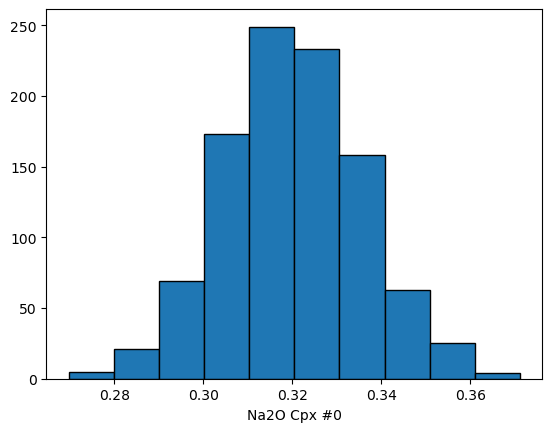
Lets first calculate Cpx-only pressures for these synthetic noisy Cpxs
[9]:
Out_5_noise_cpx_only=pt.calculate_cpx_only_press_temp(cpx_comps=Cpx_5Na2O,
equationP="P_Put2008_eq32a",
equationT="T_Put2008_eq32d", eq_tests=True)
Out_5_noise_cpx_only
[9]:
| P_kbar_calc | T_K_calc | Delta_P_kbar_Iter | Delta_T_K_Iter | SiO2_Cpx | TiO2_Cpx | Al2O3_Cpx | FeOt_Cpx | MnO_Cpx | MgO_Cpx | CaO_Cpx | Na2O_Cpx | K2O_Cpx | Cr2O3_Cpx | Sample_ID_Cpx_Num | Sample_ID_Cpx | |
|---|---|---|---|---|---|---|---|---|---|---|---|---|---|---|---|---|
| 0 | 7.176726 | 1503.404962 | 4.547474e-13 | 3.865352e-12 | 51.075956 | 0.325086 | 4.892502 | 5.714957 | 0.165700 | 16.897042 | 20.466034 | 0.303531 | 0 | 0.252186 | 0 | Feig2010_1 |
| 1 | 7.327227 | 1504.328063 | 0.000000e+00 | 0.000000e+00 | 51.075956 | 0.325086 | 4.892502 | 5.714957 | 0.165700 | 16.897042 | 20.466034 | 0.325616 | 0 | 0.252186 | 0 | Feig2010_1 |
| 2 | 7.201743 | 1503.558719 | 0.000000e+00 | 0.000000e+00 | 51.075956 | 0.325086 | 4.892502 | 5.714957 | 0.165700 | 16.897042 | 20.466034 | 0.307201 | 0 | 0.252186 | 0 | Feig2010_1 |
| 3 | 7.175275 | 1503.396041 | 0.000000e+00 | 0.000000e+00 | 51.075956 | 0.325086 | 4.892502 | 5.714957 | 0.165700 | 16.897042 | 20.466034 | 0.303318 | 0 | 0.252186 | 0 | Feig2010_1 |
| 4 | 7.476723 | 1505.240437 | 0.000000e+00 | 0.000000e+00 | 51.075956 | 0.325086 | 4.892502 | 5.714957 | 0.165700 | 16.897042 | 20.466034 | 0.347571 | 0 | 0.252186 | 0 | Feig2010_1 |
| ... | ... | ... | ... | ... | ... | ... | ... | ... | ... | ... | ... | ... | ... | ... | ... | ... |
| 6995 | 7.209419 | 1510.410826 | 0.000000e+00 | 0.000000e+00 | 52.498000 | 0.299767 | 3.517867 | 5.903067 | 0.178867 | 17.869733 | 19.342233 | 0.325852 | 0 | 0.377700 | 6 | Feig2010_7 |
| 6996 | 7.246834 | 1510.667747 | 0.000000e+00 | 0.000000e+00 | 52.498000 | 0.299767 | 3.517867 | 5.903067 | 0.178867 | 17.869733 | 19.342233 | 0.331194 | 0 | 0.377700 | 6 | Feig2010_7 |
| 6997 | 7.206544 | 1510.391084 | 0.000000e+00 | 0.000000e+00 | 52.498000 | 0.299767 | 3.517867 | 5.903067 | 0.178867 | 17.869733 | 19.342233 | 0.325442 | 0 | 0.377700 | 6 | Feig2010_7 |
| 6998 | 7.200954 | 1510.352680 | 4.547474e-13 | 3.865352e-12 | 52.498000 | 0.299767 | 3.517867 | 5.903067 | 0.178867 | 17.869733 | 19.342233 | 0.324644 | 0 | 0.377700 | 6 | Feig2010_7 |
| 6999 | 7.265069 | 1510.792914 | 0.000000e+00 | 0.000000e+00 | 52.498000 | 0.299767 | 3.517867 | 5.903067 | 0.178867 | 17.869733 | 19.342233 | 0.333797 | 0 | 0.377700 | 6 | Feig2010_7 |
7000 rows × 16 columns
Lets plot the distribution of pressures for each Cpx
[10]:
fig, ((ax1, ax2), (ax3, ax4), (ax5, ax6)) = plt.subplots(3, 2, figsize=(10, 10))
ax1.hist(Out_5_noise_cpx_only.loc[Out_5_noise_cpx_only['Sample_ID_Cpx_Num']==0, "P_kbar_calc"], bins=50, ec='k', density = True)
ax1.annotate("Cpx 1", xy=(0.02, 0.9), xycoords="axes fraction", fontsize=9)
ax2.hist(Out_5_noise_cpx_only.loc[Out_5_noise_cpx_only['Sample_ID_Cpx_Num']==1, "P_kbar_calc"], bins=50, ec='k', density = True)
ax2.annotate("Cpx 2", xy=(0.02, 0.9), xycoords="axes fraction", fontsize=9)
ax3.hist(Out_5_noise_cpx_only.loc[Out_5_noise_cpx_only['Sample_ID_Cpx_Num']==2, "P_kbar_calc"], bins=50, ec='k', density = True)
ax3.annotate("Cpx 3", xy=(0.02, 0.9), xycoords="axes fraction", fontsize=9)
ax4.hist(Out_5_noise_cpx_only.loc[Out_5_noise_cpx_only['Sample_ID_Cpx_Num']==3, "P_kbar_calc"], bins=50, ec='k', density = True)
ax4.annotate("Cpx 4", xy=(0.02, 0.9), xycoords="axes fraction", fontsize=9)
ax5.hist(Out_5_noise_cpx_only.loc[Out_5_noise_cpx_only['Sample_ID_Cpx_Num']==4, "P_kbar_calc"], bins=50, ec='k', density = True)
ax5.annotate("Cpx 5", xy=(0.02, 0.9), xycoords="axes fraction", fontsize=9)
ax6.hist(Out_5_noise_cpx_only.loc[Out_5_noise_cpx_only['Sample_ID_Cpx_Num']==5, "P_kbar_calc"], bins=50, ec='k', density = True)
ax6.annotate("Cpx 6", xy=(0.02, 0.9), xycoords="axes fraction", fontsize=9)
ax1.set_xlabel('Pressure (kbar)')
ax2.set_xlabel('Pressure (kbar)')
ax4.set_xlabel('Pressure (kbar)')
ax3.set_xlabel('Pressure (kbar)')
ax6.set_xlabel('Pressure (kbar)')
ax5.set_xlabel('Pressure (kbar)')
ax1.set_ylabel('Probability Density')
ax3.set_ylabel('Probability Density')
ax5.set_ylabel('Probability Density')
plt.rcParams['figure.dpi']= 300
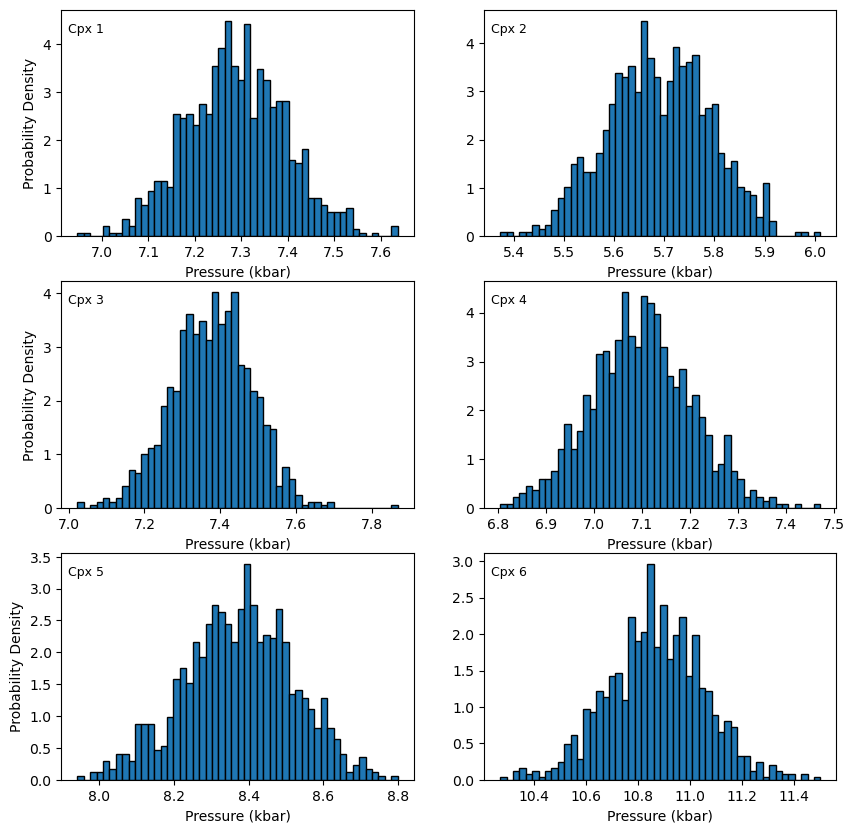
We can also calculate statistics…
The first input is the thing you want to average (e.g. the calculated temperature in this instance), the second input is the thing you want to do the averaging based on (e.g. here average all rows with the same value of “Sample_ID_Liq_Num”
[11]:
Stats_T_K_cpx_only_5=pt.av_noise_samples_series(calc=Out_5_noise_cpx_only['T_K_calc'],
sampleID=Out_5_noise_cpx_only['Sample_ID_Cpx_Num'])
Stats_T_K_cpx_only_5
[11]:
| Sample | # averaged | Mean_calc | Median_calc | St_dev_calc | St_dev_calc_from_percentiles | Max_calc | Min_calc | |
|---|---|---|---|---|---|---|---|---|
| 0 | 0 | 1000 | 1504.093704 | 1504.073654 | 0.648176 | 0.650417 | 1506.211484 | 1501.987065 |
| 1 | 1 | 1000 | 1482.816405 | 1482.801972 | 0.595222 | 0.600649 | 1484.691218 | 1480.953340 |
| 2 | 2 | 1000 | 1513.505202 | 1513.523069 | 0.602874 | 0.591517 | 1516.268401 | 1511.471754 |
| 3 | 3 | 1000 | 1505.911662 | 1505.918238 | 0.646588 | 0.649105 | 1508.216718 | 1504.083090 |
| 4 | 4 | 1000 | 1512.124246 | 1512.155947 | 0.955719 | 0.949070 | 1514.891601 | 1509.283521 |
| 5 | 5 | 1000 | 1542.923627 | 1542.907009 | 1.218478 | 1.186279 | 1547.032719 | 1538.977276 |
| 6 | 6 | 1000 | 1510.294284 | 1510.280719 | 0.751531 | 0.745849 | 1513.131975 | 1507.904170 |
[12]:
Stats_P_kbar_cpx_only_5=pt.av_noise_samples_series(calc=Out_5_noise_cpx_only['P_kbar_calc'],
sampleID=Out_5_noise_cpx_only['Sample_ID_Cpx_Num'])
Stats_P_kbar_cpx_only_5
[12]:
| Sample | # averaged | Mean_calc | Median_calc | St_dev_calc | St_dev_calc_from_percentiles | Max_calc | Min_calc | |
|---|---|---|---|---|---|---|---|---|
| 0 | 0 | 1000 | 7.289132 | 7.285674 | 0.105820 | 0.106164 | 7.636680 | 6.946966 |
| 1 | 1 | 1000 | 5.689267 | 5.686578 | 0.101599 | 0.102537 | 6.011380 | 5.373169 |
| 2 | 2 | 1000 | 7.377341 | 7.380197 | 0.105958 | 0.103965 | 7.869050 | 7.022777 |
| 3 | 3 | 1000 | 7.098185 | 7.099074 | 0.104300 | 0.104689 | 7.472012 | 6.804438 |
| 4 | 4 | 1000 | 8.374216 | 8.378836 | 0.145922 | 0.144928 | 8.798488 | 7.942115 |
| 5 | 5 | 1000 | 10.869906 | 10.867006 | 0.186282 | 0.181347 | 11.501994 | 10.269874 |
| 6 | 6 | 1000 | 7.192545 | 7.190479 | 0.109396 | 0.108558 | 7.606801 | 6.845474 |
Lets do the same but for Cpx-Liq now. Remember, only Cpx has noise added
here, T=equation 33 from Putirka 2008, P=Equation 31 from Putirka 2008
[13]:
Out_5_noise_cpx_liq=pt.calculate_cpx_liq_press_temp(liq_comps=Liquids_only_noNoise, cpx_comps=Cpx_5Na2O,
equationP="P_Put2008_eq31", equationT="T_Put2008_eq33", eq_tests=True)
Using Fe3FeT from input file to calculate Kd Fe-Mg
Each histogram shows the pressure distribution from a single Cpx-Liquid pair resulting from adding 5% error to just Na in Cpx.
Here we use the loc function to find all the rows where Cpx_Num==0, e.g. this is the first liquid in your excel spreadsheet.
If you wanted the 6th liquid instead, change ==0 to ==5 (as python starts its numbering from 0)
[14]:
fig, ((ax1, ax2), (ax3, ax4), (ax5, ax6)) = plt.subplots(3, 2, figsize=(10, 10))
ax1.hist(Out_5_noise_cpx_liq.loc[Out_5_noise_cpx_liq['Sample_ID_Cpx_Num']==0, "P_kbar_calc"], bins=50, ec='k', density = True)
ax1.annotate("Liquid 1-Cpx 1", xy=(0.02, 0.9), xycoords="axes fraction", fontsize=9)
ax2.hist(Out_5_noise_cpx_liq.loc[Out_5_noise_cpx_liq['Sample_ID_Cpx_Num']==1, "P_kbar_calc"], bins=50, ec='k', density = True)
ax2.annotate("Liquid 2-Cpx 2", xy=(0.02, 0.9), xycoords="axes fraction", fontsize=9)
ax3.hist(Out_5_noise_cpx_liq.loc[Out_5_noise_cpx_liq['Sample_ID_Cpx_Num']==2, "P_kbar_calc"], bins=50, ec='k', density = True)
ax3.annotate("Liquid 3-Cpx 3", xy=(0.02, 0.9), xycoords="axes fraction", fontsize=9)
ax4.hist(Out_5_noise_cpx_liq.loc[Out_5_noise_cpx_liq['Sample_ID_Cpx_Num']==3, "P_kbar_calc"], bins=50, ec='k', density = True)
ax4.annotate("Liquid 4-Cpx 4", xy=(0.02, 0.9), xycoords="axes fraction", fontsize=9)
ax5.hist(Out_5_noise_cpx_liq.loc[Out_5_noise_cpx_liq['Sample_ID_Cpx_Num']==4, "P_kbar_calc"], bins=50, ec='k', density = True)
ax5.annotate("Liquid 5-Cpx 5", xy=(0.02, 0.9), xycoords="axes fraction", fontsize=9)
ax6.hist(Out_5_noise_cpx_liq.loc[Out_5_noise_cpx_liq['Sample_ID_Cpx_Num']==5, "P_kbar_calc"], bins=50, ec='k', density = True)
ax6.annotate("Liquid 6-Cpx 6", xy=(0.02, 0.9), xycoords="axes fraction", fontsize=9)
ax6.set_xlabel('Pressure (kbar)')
ax5.set_xlabel('Pressure (kbar)')
ax1.set_ylabel('Probability Density')
plt.rcParams['figure.dpi']= 300
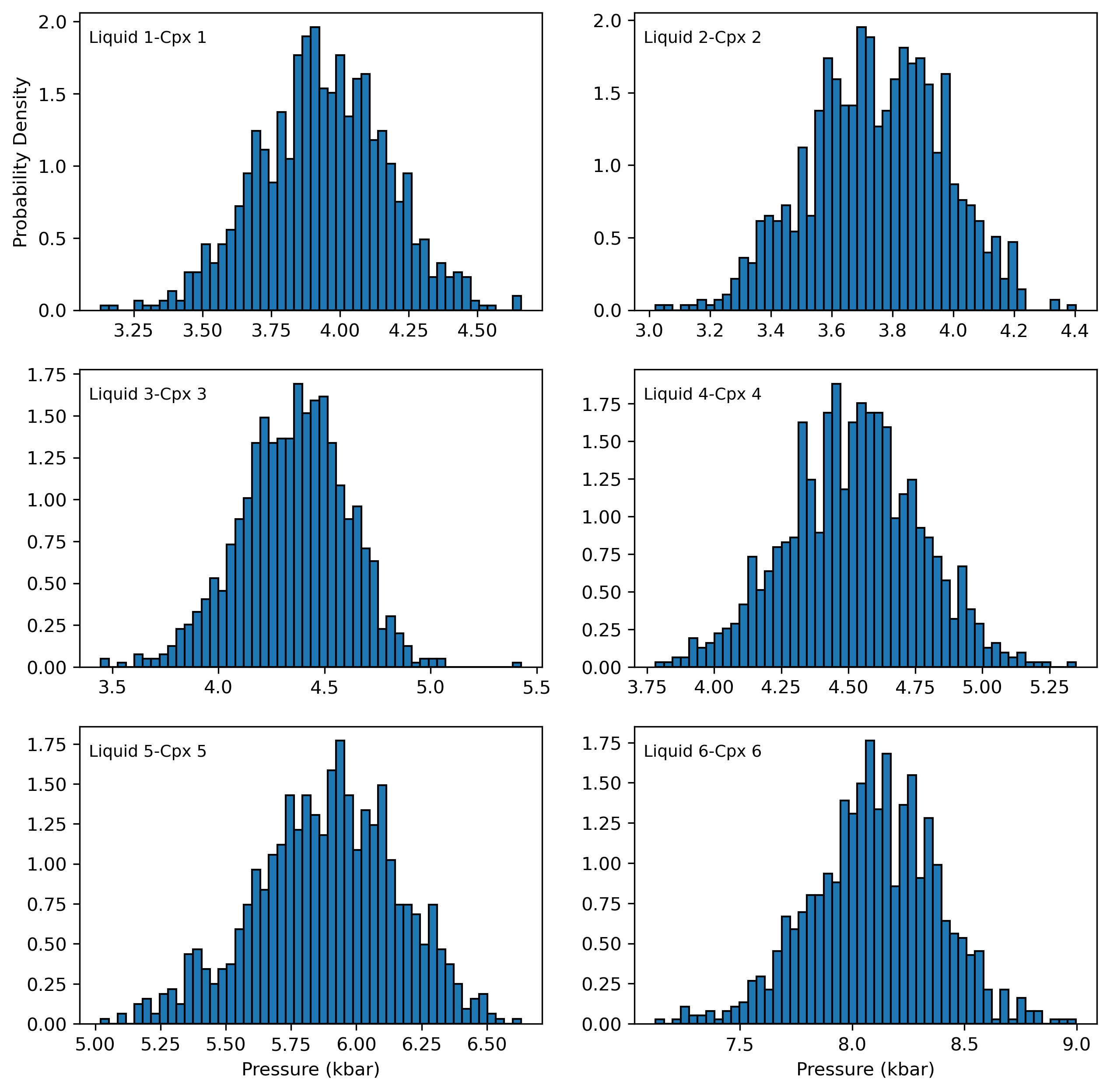
Calculate Statistics
[15]:
Stats_T_K_Cpx_Liq_5Na=pt.av_noise_samples_series(calc=Out_5_noise_cpx_liq['T_K_calc'],
sampleID=Out_5_noise_cpx_liq['Sample_ID_Liq_Num'])
Stats_T_K_Cpx_Liq_5Na
[15]:
| Sample | # averaged | Mean_calc | Median_calc | St_dev_calc | St_dev_calc_from_percentiles | Max_calc | Min_calc | |
|---|---|---|---|---|---|---|---|---|
| 0 | 0 | 1000 | 1344.982511 | 1344.958241 | 2.301838 | 2.310553 | 1352.085607 | 1337.008279 |
| 1 | 1 | 1000 | 1300.471799 | 1300.463114 | 2.083761 | 2.096915 | 1306.682126 | 1293.558853 |
| 2 | 2 | 1000 | 1384.044844 | 1384.169824 | 2.557811 | 2.502963 | 1394.872090 | 1374.869885 |
| 3 | 3 | 1000 | 1397.655967 | 1397.732071 | 2.532384 | 2.542268 | 1406.150489 | 1390.108260 |
| 4 | 4 | 1000 | 1402.163076 | 1402.318650 | 2.799021 | 2.767411 | 1409.808446 | 1393.333109 |
| 5 | 5 | 1000 | 1472.955481 | 1472.976203 | 3.010838 | 2.925995 | 1482.505951 | 1462.579731 |
| 6 | 6 | 1000 | 1481.018692 | 1481.026769 | 3.055057 | 3.033336 | 1491.803278 | 1470.660817 |
[16]:
Stats_P_kbar_Cpx_Liq_5Na=pt.av_noise_samples_series(calc=Out_5_noise_cpx_liq['P_kbar_calc'],
sampleID=Out_5_noise_cpx_liq['Sample_ID_Liq_Num'])
Stats_P_kbar_Cpx_Liq_5Na
[16]:
| Sample | # averaged | Mean_calc | Median_calc | St_dev_calc | St_dev_calc_from_percentiles | Max_calc | Min_calc | |
|---|---|---|---|---|---|---|---|---|
| 0 | 0 | 1000 | 3.938405 | 3.935952 | 0.233353 | 0.234232 | 4.658471 | 3.129855 |
| 1 | 1 | 1000 | 3.748771 | 3.747827 | 0.219479 | 0.220866 | 4.403187 | 3.020858 |
| 2 | 2 | 1000 | 4.353823 | 4.366204 | 0.253318 | 0.247879 | 5.426241 | 3.445041 |
| 3 | 3 | 1000 | 4.518883 | 4.526332 | 0.247352 | 0.248313 | 5.348489 | 3.781491 |
| 4 | 4 | 1000 | 5.883760 | 5.898955 | 0.273494 | 0.270400 | 6.630888 | 5.020960 |
| 5 | 5 | 1000 | 8.099023 | 8.100936 | 0.282918 | 0.274941 | 8.996880 | 7.124293 |
| 6 | 6 | 1000 | 6.239598 | 6.240434 | 0.278082 | 0.276099 | 7.220138 | 5.295689 |
Example 2 - published absolute 1 sigma values for all oxides
Here, we use the published 1 sigma values for each oxide in both the glass and cpx reported by Feig et al. 2010
We make a noisy dataframe of the same length for liquids and cpxs, then combine them into the function for iterating P and T
First, load in the published 1 sigma values
[17]:
out_err=pt.import_excel_errors('Cpx_Liq_Error_prop_Feig2010_example.xlsx', sheet_name="Sheet1")
myLiquids1_err=out_err['Liqs_Err']
myCpxs1_err=out_err['Cpxs_Err']
myinput_Out=out_err['my_input_Err']
## Check input looks reasonable
display(myCpxs1_err.head())
display(myLiquids1_err.head())
| SiO2_Cpx_Err | TiO2_Cpx_Err | Al2O3_Cpx_Err | FeOt_Cpx_Err | MnO_Cpx_Err | MgO_Cpx_Err | CaO_Cpx_Err | Na2O_Cpx_Err | K2O_Cpx_Err | Cr2O3_Cpx_Err | P_kbar_Err | T_K_Err | Sample_ID_Cpx_Err | |
|---|---|---|---|---|---|---|---|---|---|---|---|---|---|
| 0 | 0.400044 | 0.032172 | 0.510460 | 0.357680 | 0.023249 | 0.538039 | 0.645164 | 0.049138 | 0 | 0.034646 | 0 | 0 | 0 |
| 1 | 0.628064 | 0.067227 | 0.622601 | 0.657476 | 0.050037 | 0.732816 | 1.050758 | 0.060948 | 0 | 0.062095 | 0 | 0 | 1 |
| 2 | 0.585596 | 0.032846 | 0.918768 | 0.506392 | 0.000000 | 0.562266 | 0.794310 | 0.107095 | 0 | 0.210114 | 0 | 0 | 2 |
| 3 | 0.165277 | 0.032709 | 0.240924 | 0.207266 | 0.051434 | 0.182666 | 0.355487 | 0.048979 | 0 | 0.058814 | 0 | 0 | 3 |
| 4 | 0.106509 | 0.040535 | 0.479962 | 0.428886 | 0.026673 | 0.431550 | 0.486264 | 0.056668 | 0 | 0.051372 | 0 | 0 | 4 |
| SiO2_Liq_Err | TiO2_Liq_Err | Al2O3_Liq_Err | FeOt_Liq_Err | MnO_Liq_Err | MgO_Liq_Err | CaO_Liq_Err | Na2O_Liq_Err | K2O_Liq_Err | Cr2O3_Liq_Err | P2O5_Liq_Err | H2O_Liq_Err | Fe3Fet_Liq_Err | NiO_Liq_Err | CoO_Liq_Err | CO2_Liq_Err | Sample_ID_Liq_Err | P_kbar_Err | T_K_Err | |
|---|---|---|---|---|---|---|---|---|---|---|---|---|---|---|---|---|---|---|---|
| 0 | 0.326030 | 0.042448 | 0.221884 | 0.432684 | 0 | 0.207011 | 0.268045 | 0.213647 | 0 | 0 | 0 | 0.2560 | 0 | 0 | 0 | 0 | 0 | 0 | 0 |
| 1 | 0.328698 | 0.025182 | 0.242675 | 0.214755 | 0 | 0.163292 | 0.171717 | 0.085388 | 0 | 0 | 0 | 0.2590 | 0 | 0 | 0 | 0 | 1 | 0 | 0 |
| 2 | 0.476011 | 0.027083 | 0.235814 | 0.301696 | 0 | 0.174436 | 0.206030 | 0.229583 | 0 | 0 | 0 | 0.2525 | 0 | 0 | 0 | 0 | 2 | 0 | 0 |
| 3 | 0.442894 | 0.047517 | 0.234808 | 0.219780 | 0 | 0.171799 | 0.274484 | 0.259757 | 0 | 0 | 0 | 0.1335 | 0 | 0 | 0 | 0 | 3 | 0 | 0 |
| 4 | 0.445356 | 0.043963 | 0.316155 | 0.389311 | 0 | 0.134659 | 0.209045 | 0.453723 | 0 | 0 | 0 | 0.1125 | 0 | 0 | 0 | 0 | 4 | 0 | 0 |
[18]:
# Make noise based on reported absolute 1 sigma errors from Feig et al (2010) for liquids
Liquids_st_noise=pt.add_noise_sample_1phase(phase_comp=myLiquids1, phase_err=myLiquids1_err,
phase_err_type="Abs", duplicates=1000, err_dist="normal")
# Make noise based on reported absolute 1 sigma errors from Feig et al (2010) for Cpx
Cpxs_st_noise=pt.add_noise_sample_1phase(phase_comp=myCpxs1, phase_err=myCpxs1_err,
phase_err_type="Abs", duplicates=1000, err_dist="normal")
All negative numbers replaced with zeros. If you wish to keep these, set positive=False
All negative numbers replaced with zeros. If you wish to keep these, set positive=False
[19]:
Out_st_noise=pt.calculate_cpx_liq_press_temp(liq_comps=Liquids_st_noise, cpx_comps=Cpxs_st_noise,
equationP="P_Put2008_eq31",
equationT="T_Put2008_eq33", eq_tests=True)
Out_st_noise['Sample_ID_Liq']=Liquids_st_noise['Sample_ID_Liq']
Using Fe3FeT from input file to calculate Kd Fe-Mg
[20]:
Stats_T_K_CpxLiqPubErr=pt.av_noise_samples_series(Out_st_noise['T_K_calc'], Liquids_st_noise['Sample_ID_Liq_Num'])
Stats_T_K_CpxLiqPubErr
[20]:
| Sample | # averaged | Mean_calc | Median_calc | St_dev_calc | St_dev_calc_from_percentiles | Max_calc | Min_calc | |
|---|---|---|---|---|---|---|---|---|
| 0 | 0.0 | 1000 | 1344.778009 | 1344.735392 | 11.156826 | 10.840918 | 1375.682470 | 1302.872509 |
| 1 | 1.0 | 1000 | 1298.258746 | 1299.281954 | 14.254824 | NaN | 1330.315266 | 1175.080944 |
| 2 | 2.0 | 1000 | 1381.502327 | 1383.813019 | 22.308766 | 19.837978 | 1435.279079 | 1264.203025 |
| 3 | 3.0 | 1000 | 1397.162764 | 1397.509669 | 10.235910 | 10.054889 | 1426.196935 | 1355.266807 |
| 4 | 4.0 | 1000 | 1402.318585 | 1402.558428 | 11.082536 | 10.794108 | 1437.824694 | 1360.557106 |
| 5 | 5.0 | 1000 | 1472.681192 | 1472.671170 | 6.863751 | 6.509604 | 1493.673102 | 1452.546075 |
| 6 | 6.0 | 1000 | 1480.309567 | 1480.395505 | 9.144380 | 8.975709 | 1516.852760 | 1452.699821 |
[21]:
Stats_P_kbar_CpxLiqPubErr=pt.av_noise_samples_series(Out_st_noise['P_kbar_calc'], Liquids_st_noise['Sample_ID_Liq_Num'])
Stats_P_kbar_CpxLiqPubErr
[21]:
| Sample | # averaged | Mean_calc | Median_calc | St_dev_calc | St_dev_calc_from_percentiles | Max_calc | Min_calc | |
|---|---|---|---|---|---|---|---|---|
| 0 | 0.0 | 1000 | 3.905501 | 3.934258 | 0.803513 | 0.784033 | 6.176492 | 1.083341 |
| 1 | 1.0 | 1000 | 3.604391 | 3.759577 | 1.267754 | NaN | 5.990290 | -10.913168 |
| 2 | 2.0 | 1000 | 4.130971 | 4.401500 | 2.075102 | 1.791349 | 8.134930 | -7.126329 |
| 3 | 3.0 | 1000 | 4.471886 | 4.488412 | 0.856214 | 0.816977 | 6.709085 | 0.742520 |
| 4 | 4.0 | 1000 | 5.882646 | 5.916289 | 0.914733 | 0.852087 | 8.154560 | 2.183166 |
| 5 | 5.0 | 1000 | 8.087495 | 8.087377 | 0.492009 | 0.474018 | 9.712500 | 6.424784 |
| 6 | 6.0 | 1000 | 6.193959 | 6.206869 | 0.486849 | 0.456279 | 7.561456 | 4.587588 |
Recreate plot shown in manuscript for just 2 cpx-liq pairs from experiments
Here, on the LHS we plot cpx-liq pairs from the first row of the spreadsheet (ID=0)
On the RHS, we plot the pairs from row 4 (ID=3)
[22]:
fig, ((ax1, ax2)) = plt.subplots(1, 2, figsize=(12, 4))
ax1.hist(Out_st_noise.loc[Out_st_noise['Sample_ID_Liq_Num']==0, "P_kbar_calc"], bins=50, ec='k', density = True)
ax1.annotate("Liquid 1-Cpx 1", xy=(0.02, 0.95), xycoords="axes fraction", fontsize=9)
ax2.hist(Out_st_noise.loc[Out_st_noise['Sample_ID_Liq_Num']==3, "P_kbar_calc"], bins=50, ec='k', density = True)
ax2.annotate("Liquid 3-Cpx 3", xy=(0.02, 0.95), xycoords="axes fraction", fontsize=9)
#ax2.set_xlim([0, 6])
ax1.set_xlabel('Pressure (kbar)')
ax2.set_xlabel('Pressure (kbar)')
ax1.set_ylabel('Probability Density')
ax2.set_ylabel('Probability Density')
fig.savefig('Manuscript_2CpxNoises.png', dpi=300, transparent=True)
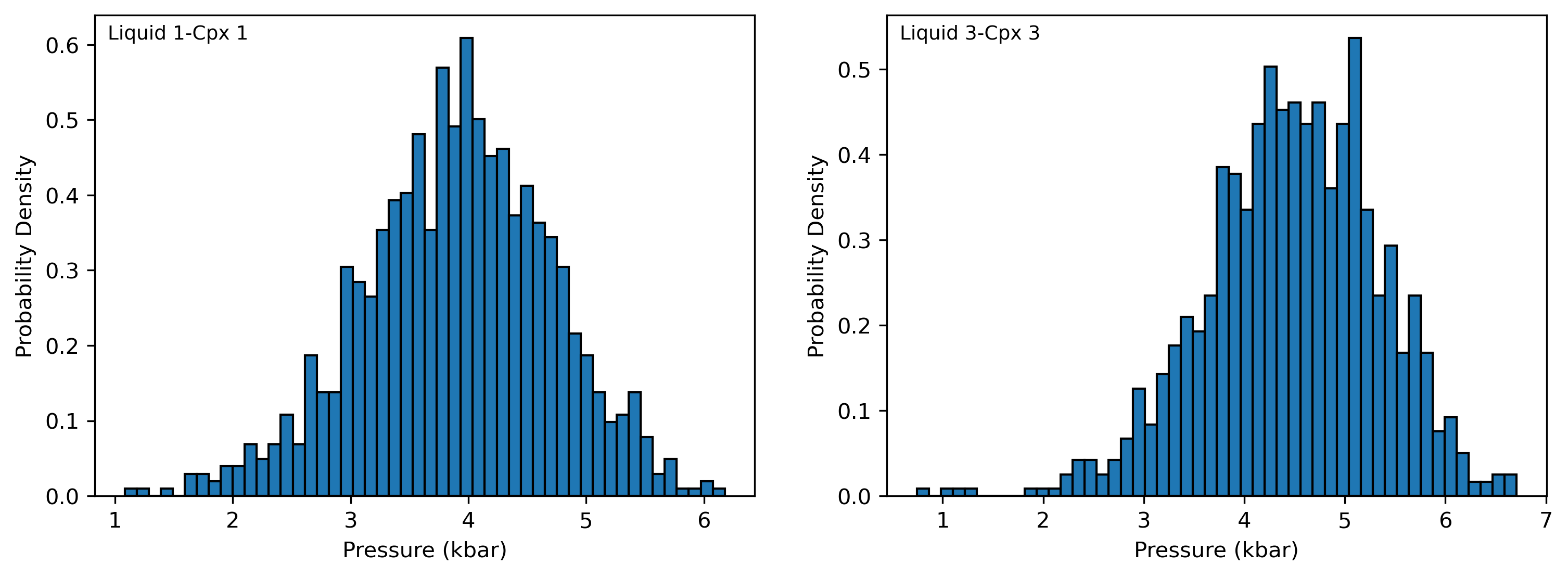
Plot for 6 separate cpx-liq pairs
can average by _Cpx or _Liq, doesnt matter, as will match
[23]:
fig, ((ax1, ax2), (ax3, ax4), (ax5, ax6)) = plt.subplots(3, 2, figsize=(10, 10))
ax1.hist(Out_st_noise.loc[Out_st_noise['Sample_ID_Cpx_Num']==0, "P_kbar_calc"], bins=50, ec='k', density = True)
ax1.annotate("Liquid 1-Cpx 1", xy=(0.02, 0.9), xycoords="axes fraction", fontsize=9)
ax2.hist(Out_st_noise.loc[Out_st_noise['Sample_ID_Cpx_Num']==1, "P_kbar_calc"], bins=50, ec='k', density = True)
ax2.annotate("Liquid 2-Cpx 2", xy=(0.02, 0.9), xycoords="axes fraction", fontsize=9)
ax3.hist(Out_st_noise.loc[Out_st_noise['Sample_ID_Cpx_Num']==2, "P_kbar_calc"], bins=50, ec='k', density = True)
ax3.annotate("Liquid 3-Cpx 3", xy=(0.02, 0.9), xycoords="axes fraction", fontsize=9)
ax4.hist(Out_st_noise.loc[Out_st_noise['Sample_ID_Cpx_Num']==3, "P_kbar_calc"], bins=50, ec='k', density = True)
ax4.annotate("Liquid 4-Cpx 4", xy=(0.02, 0.9), xycoords="axes fraction", fontsize=9)
ax5.hist(Out_st_noise.loc[Out_st_noise['Sample_ID_Cpx_Num']==4, "P_kbar_calc"], bins=50, ec='k', density = True)
ax5.annotate("Liquid 5-Cpx 5", xy=(0.02, 0.9), xycoords="axes fraction", fontsize=9)
ax6.hist(Out_st_noise.loc[Out_st_noise['Sample_ID_Cpx_Num']==5, "P_kbar_calc"], bins=50, ec='k', density = True)
ax6.annotate("Liquid 6-Cpx 6", xy=(0.02, 0.9), xycoords="axes fraction", fontsize=9)
ax2.set_xlim([0, 6])
ax6.set_xlabel('Pressure (kbar)')
ax5.set_xlabel('Pressure (kbar)')
ax1.set_ylabel('Probability Density')
ax3.set_ylabel('Probability Density')
ax5.set_ylabel('Probability Density')
[23]:
Text(0, 0.5, 'Probability Density')
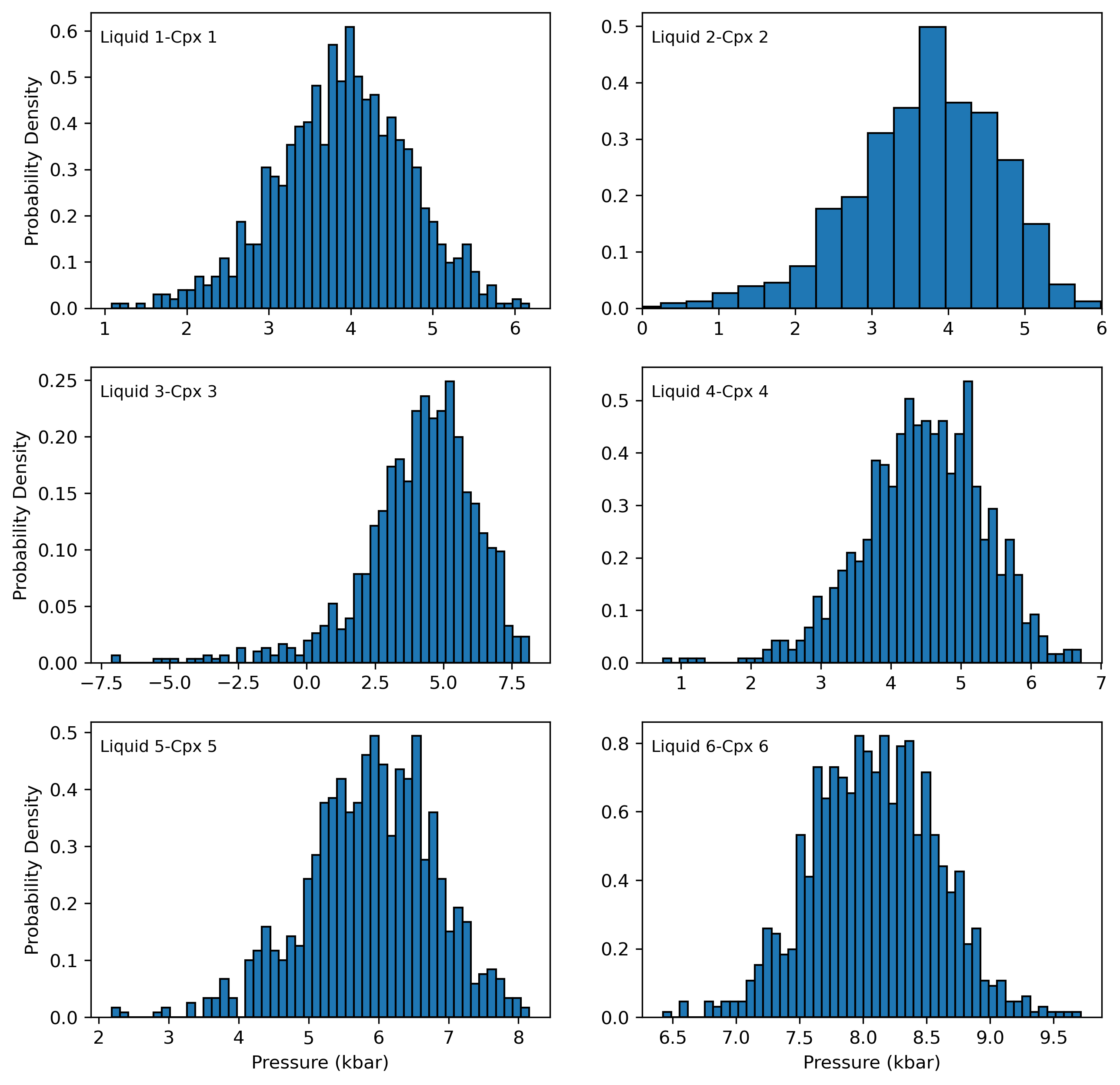
Temperature distributions for first 6 pairs
[24]:
fig, ((ax1, ax2), (ax3, ax4), (ax5, ax6)) = plt.subplots(3, 2, figsize=(10, 10))
ax1.hist(Out_st_noise.loc[Out_st_noise['Sample_ID_Cpx_Num']==0, "T_K_calc"], bins=50, ec='k', density = True)
ax2.hist(Out_st_noise.loc[Out_st_noise['Sample_ID_Cpx_Num']==1, "T_K_calc"], bins=50, ec='k', density = True)
ax3.hist(Out_st_noise.loc[Out_st_noise['Sample_ID_Cpx_Num']==2, "T_K_calc"], bins=50, ec='k', density = True)
ax4.hist(Out_st_noise.loc[Out_st_noise['Sample_ID_Cpx_Num']==3, "T_K_calc"], bins=50, ec='k', density = True)
ax5.hist(Out_st_noise.loc[Out_st_noise['Sample_ID_Cpx_Num']==4, "T_K_calc"], bins=50, ec='k', density = True)
ax6.hist(Out_st_noise.loc[Out_st_noise['Sample_ID_Cpx_Num']==5, "T_K_calc"], bins=50, ec='k', density = True)
ax6.set_xlabel('T (K)')
ax5.set_xlabel('T (K)')
ax1.set_ylabel('Probability Density')
ax3.set_ylabel('Probability Density')
ax5.set_ylabel('Probability Density')
[24]:
Text(0, 0.5, 'Probability Density')
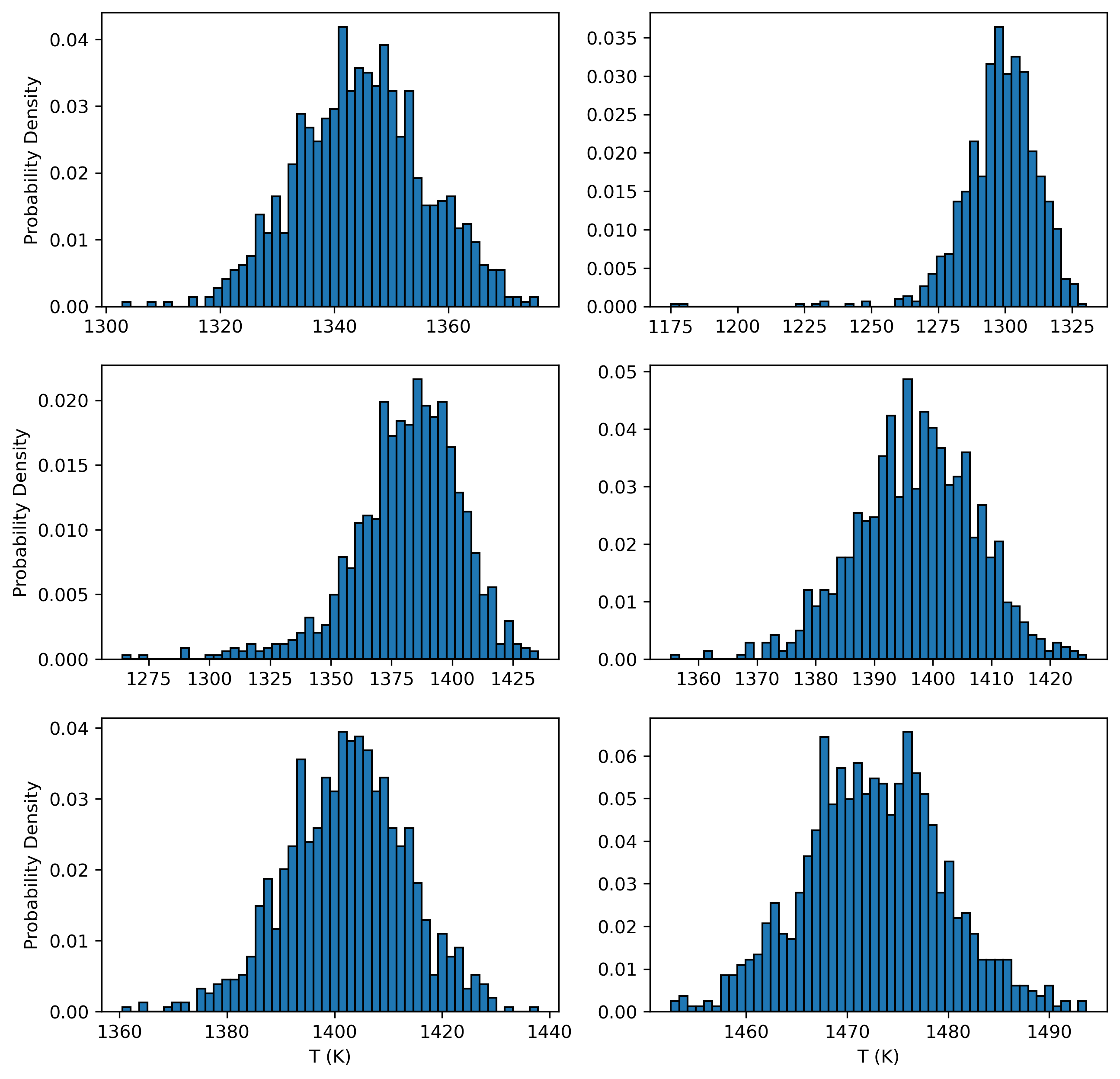
Plots with conventional errorbars for each Cpx-Liq pair
Note, although this is typically how thermobarometric data is displayed, it isnt very realistic, our error propagation shows that error ellipses would be better - see the example below
[25]:
fig, (ax1) = plt.subplots(1, 1, figsize=(3, 2.5))
ax1.errorbar(Stats_T_K_CpxLiqPubErr['Mean_calc'],
Stats_P_kbar_CpxLiqPubErr['Mean_calc'],
xerr=Stats_T_K_CpxLiqPubErr['St_dev_calc'],
yerr=Stats_P_kbar_CpxLiqPubErr['St_dev_calc'],
fmt='d', ecolor='k', elinewidth=0.8, mfc='cyan', ms=5, mec='k')
ax1.set_ylabel('Calculated P (kbar)')
ax1.set_xlabel('Calculated T (K)')
[25]:
Text(0.5, 0, 'Calculated T (K)')
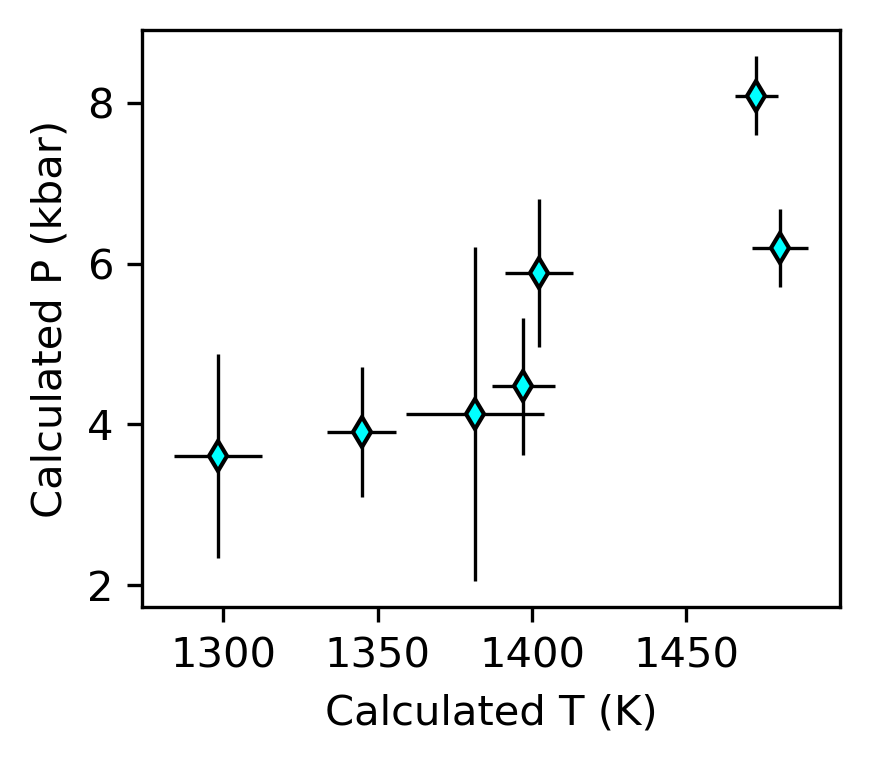
Error ellipses instead
[26]:
Out_st_noise.columns[0:100]
[26]:
Index(['P_kbar_calc', 'T_K_calc', 'Eq Tests Neave2017?', 'Delta_P_kbar_Iter',
'Delta_T_K_Iter', 'Delta_Kd_Put2008', 'Delta_Kd_Mas2013',
'Delta_EnFs_Mollo13', 'Delta_EnFs_Put1999', 'Delta_CaTs_Put1999',
'Delta_DiHd_Mollo13', 'Delta_DiHd_Put1999', 'Delta_CrCaTs_Put1999',
'Delta_CaTi_Put1999', 'SiO2_Liq', 'TiO2_Liq', 'Al2O3_Liq', 'FeOt_Liq',
'MnO_Liq', 'MgO_Liq', 'CaO_Liq', 'Na2O_Liq', 'K2O_Liq', 'Cr2O3_Liq',
'P2O5_Liq', 'H2O_Liq', 'Fe3Fet_Liq', 'NiO_Liq', 'CoO_Liq', 'CO2_Liq',
'Sample_ID_Liq_Num', 'SiO2_Liq_mol_frac', 'MgO_Liq_mol_frac',
'MnO_Liq_mol_frac', 'FeOt_Liq_mol_frac', 'CaO_Liq_mol_frac',
'Al2O3_Liq_mol_frac', 'Na2O_Liq_mol_frac', 'K2O_Liq_mol_frac',
'TiO2_Liq_mol_frac', 'P2O5_Liq_mol_frac', 'Cr2O3_Liq_mol_frac',
'Si_Liq_cat_frac', 'Mg_Liq_cat_frac', 'Mn_Liq_cat_frac',
'Fet_Liq_cat_frac', 'Ca_Liq_cat_frac', 'Al_Liq_cat_frac',
'Na_Liq_cat_frac', 'K_Liq_cat_frac', 'Ti_Liq_cat_frac',
'P_Liq_cat_frac', 'Cr_Liq_cat_frac', 'Mg_Number_Liq_NoFe3',
'Mg_Number_Liq_Fe3', 'SiO2_Cpx', 'TiO2_Cpx', 'Al2O3_Cpx', 'FeOt_Cpx',
'MnO_Cpx', 'MgO_Cpx', 'CaO_Cpx', 'Na2O_Cpx', 'K2O_Cpx', 'Cr2O3_Cpx',
'Sample_ID_Cpx_Num', 'Si_Cpx_cat_6ox', 'Mg_Cpx_cat_6ox',
'Fet_Cpx_cat_6ox', 'Ca_Cpx_cat_6ox', 'Al_Cpx_cat_6ox', 'Na_Cpx_cat_6ox',
'K_Cpx_cat_6ox', 'Mn_Cpx_cat_6ox', 'Ti_Cpx_cat_6ox', 'Cr_Cpx_cat_6ox',
'oxy_renorm_factor', 'Al_IV_cat_6ox', 'Al_VI_cat_6ox',
'En_Simple_MgFeCa_Cpx', 'Fs_Simple_MgFeCa_Cpx', 'Wo_Simple_MgFeCa_Cpx',
'Cation_Sum_Cpx', 'Ca_CaMgFe', 'Lindley_Fe3_Cpx', 'Lindley_Fe2_Cpx',
'Lindley_Fe3_Cpx_prop', 'CrCaTs', 'a_cpx_En', 'Mgno_Cpx', 'Jd',
'Jd_from 0=Na, 1=Al', 'CaTs', 'CaTi', 'DiHd_1996', 'EnFs', 'DiHd_2003',
'Di_Cpx', 'FeIII_Wang21', 'FeII_Wang21'],
dtype='object')
[27]:
Out_st_noise['Sample_ID_Liq'].unique()[0]
[27]:
'Feig2010_1'
[28]:
fig, (ax0, ax1) = plt.subplots(1, 2, figsize=(10, 4))
# you have to plot something on the axis before you try to add the confidence intervals
ax0.plot(Stats_T_K_CpxLiqPubErr['Mean_calc'],
Stats_P_kbar_CpxLiqPubErr['Mean_calc'], 'ok', mfc='red', ms=4)
for sam in Out_st_noise['Sample_ID_Liq'].unique():
Calc_PT_16=Out_st_noise.loc[Out_st_noise['Sample_ID_Liq']==sam].reset_index(drop=True)
y=Calc_PT_16['P_kbar_calc'].loc[Calc_PT_16['P_kbar_calc']>-10].values
x=Calc_PT_16['T_K_calc'].loc[Calc_PT_16['P_kbar_calc']>-10].values
pt.matplotlib_confidence_ellipse(x, y, ax0, n_std=1,
edgecolor='r', lw=0.5, alpha=0.8)
ax0.set_xlabel('T (K)')
ax0.set_ylabel('P (kbar)')
ax1.plot(Stats_T_K_CpxLiqPubErr['Mean_calc'],
Stats_P_kbar_CpxLiqPubErr['Mean_calc'], 'ok', mfc='red', ms=4)
for sam in Out_st_noise['Sample_ID_Liq'].unique():
Calc_PT_16=Out_st_noise.loc[Out_st_noise['Sample_ID_Liq']==sam].reset_index(drop=True)
y=Calc_PT_16['P_kbar_calc'].loc[Calc_PT_16['P_kbar_calc']>-10].values
x=Calc_PT_16['T_K_calc'].loc[Calc_PT_16['P_kbar_calc']>-10].values
if sam==Out_st_noise['Sample_ID_Liq'].unique()[0]:
pt.matplotlib_confidence_ellipse(x, y, ax1, n_std=1,
edgecolor='red', lw=0.5, alpha=0.8, label='1σ MC simulations')
else:
pt.matplotlib_confidence_ellipse(x, y, ax1, n_std=1,
edgecolor='red', lw=0.5, alpha=0.8)
ax1.set_xlabel('T (K)')
ax1.set_ylabel('P (kbar)')
ax1.errorbar(Stats_T_K_CpxLiqPubErr['Mean_calc'],
Stats_P_kbar_CpxLiqPubErr['Mean_calc'],
xerr=Stats_T_K_CpxLiqPubErr['St_dev_calc'],
yerr=Stats_P_kbar_CpxLiqPubErr['St_dev_calc'],
fmt='o', ecolor='k', elinewidth=0.8, mfc='red', ms=5, mec='k', label='Conventional error bars')
ax1.legend()
ax0.set_title('Cpx-Liq Error ellipses')
ax1.set_title('Cpx-Liq Error bars vs. ellipses')
fig.savefig('confidence_intervals_vs_errorbars.png', dpi=200)
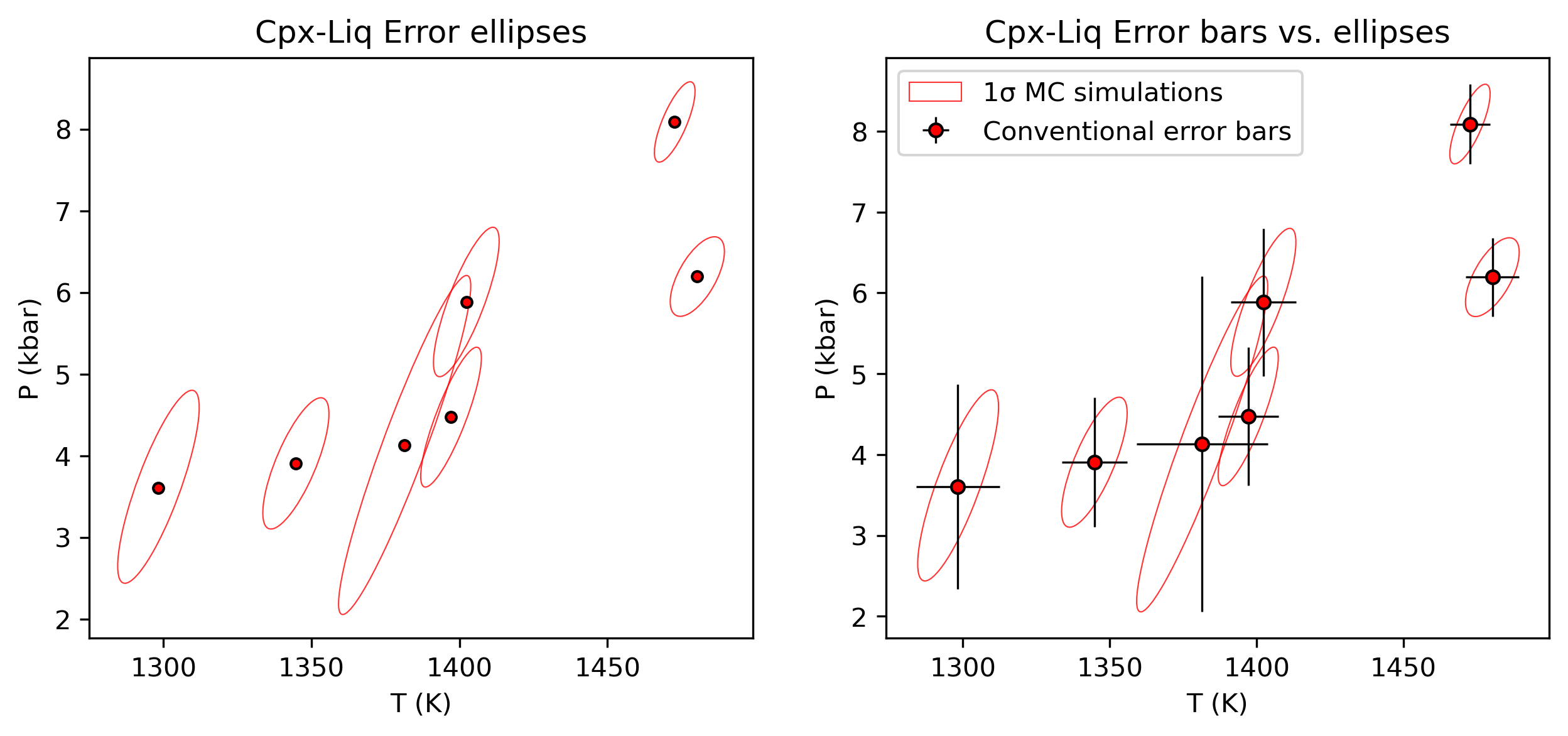
[ ]:
[ ]:
[ ]:
[ ]:
[ ]: